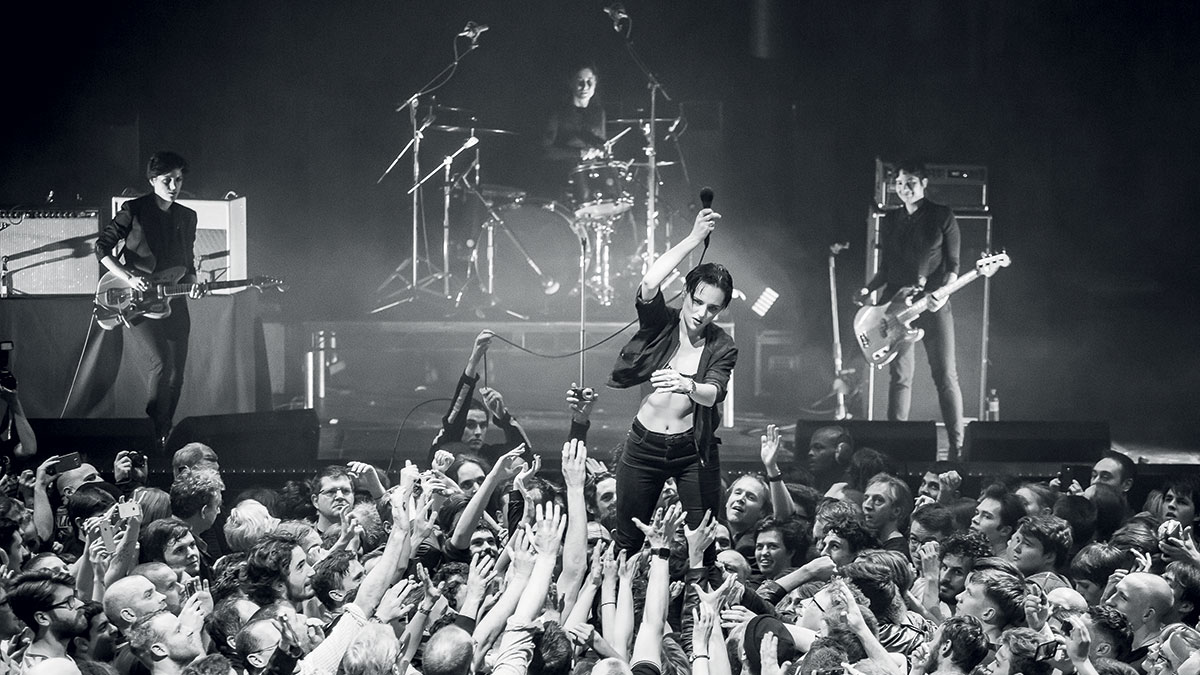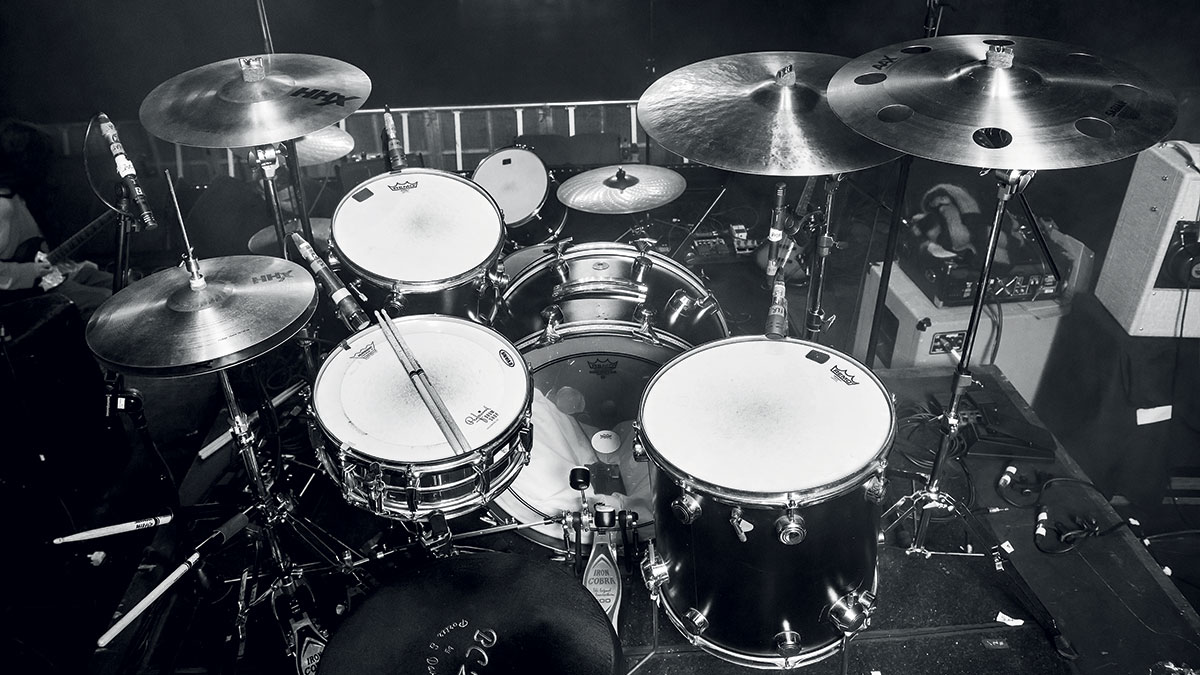Fay Milton's five steps to drumming stardom
Savages stickswoman on early days, gear and more

Savages stickswoman on early days, gear and more
"It’s been flying by the seat of our pants a bit,” admits Fay Milton, metronomic powerhouse behind Anglo-French post-punk outfit Savages as the band conclude a phenomenal UK tour with a typical rapturously-received gig at London’s Roundhouse.
“We’re quite rushed off our feet,” she says. “Basically, it’s the last show of our tour and it’s always a big build-up to the last show. it’s always a big build-up to a London show, and as well because we’re from London and then you have friends and family there.
“There was a lot of build-up to that [London] show in lots of ways and so it felt really, really good to have a real ball actually, and everyone was really up for it. It was kind of a big party crowd which is really nice in big cities like London where sometimes they grow world weary because they’ve seen so many shows.”
If you haven’t yet subjected yourself to the visceral raw energy of Savages, you’d better get a shift on if you want to keep your hipster credentials, fella. The all-female post-punk rockers are, despite having already released one album back in 2013, Silence Yourself, everybody’s Next Big Thing.
With their hypnotic grooves, raw live energy and the Siouxsie-like vocals of livewire frontwoman Jehnny Beth, the band are picking up plaudits in the UK, Beth’s native France and North America – where they played shows with the lately-reformed LCD Soundsystem.
Here we chart the rise of the Anglo-French foursome by uncovering Fay’s five steps to drumming stardom.

1. Early days
Fay started out on her rhythmic journey by playing percussion in the school orchestra. “When I was a kid, me and my best friend Lucy, we were really little, physically, and really young as well. I felt it would be really hilarious if we both played the drums.
“That was something that these big guys did and we were these tiny little girls and I think we really relished the kind of humour in that, we were really cheeky. When you’re young, you have a thing and you do it. It’s only when you get older you start questioning whether it’s the right thing, or what should you do. Some people do sport, I did music.
"I got quite disillusioned with the classical world because it’s all or nothing."
“That continued until I went to University to do music. But yeah, that inevitable questioning comes, why am I doing this [orchestra]? I got quite disillusioned with the classical world because it’s all or nothing, you dedicate your life to that and then you’re at the very top of the top, especially in percussion, there’s not an awful lot of work in reality for a classical musician, a percussionist as well.
So when the reality hit home, I stopped playing for quite a long time. Then I saw people playing the drums – quite badly – and it made me think I could do better than that so I started playing again.”

2. Bedroom beginnings
For Fay, her rollercoaster ride with Savages began when a mutual friend connected her with the three other members of the band – frontwoman Beth, guitarist Gemma Thompson and bass player Ayse Hassan – when they were still finding their sound.
“They started a few songs but hadn’t really got together yet, it was all bedroom stuff,” recalls Fay. “We all got together one day in the studio, we all had a good time and it was really interesting.
“I think all four of us, what we were trying to do at that point was really different so it was a process of fitting in with each other, although it was different. We were all learning from each other, I think. We’re all enjoying having our ideas challenged, so somehow we got together and just never split up.”

3. Studio Sessions
To achieve the kind of industrial, machine-like quality behind Fay’s drums on the record, Fay laid down a rhythm track, then afterwards re-recorded every drum hit separately.
“We’d record a really good take of the song altogether and then we’d go back and do everything all over again,” she explains. “I definitely like that sound because I’m more into the more mechanical drums, like a drum machine kind of vibe. It was a massive ball-ache, it was so hard to record every single drum and every single cymbal separately!
“I’ve heard stories of other drummers going into mental breakdown trying to do that! I didn’t go into mental breakdown – it was pretty stressful but i’m really happy with the sound so it’s all for the greater good.
"It was so hard to record every single drum and every single cymbal separately!"
“We start with the kick and then do the snare,” she explains. “Not on every song but on a song like The Answer which has a really fast pattern. It repeats over and over but it doesn’t repeat in exactly the same way, there’s variations of it all the way through that come up in random places, it’s semi-improvised. I always added the cymbals after the drums.
“I think it was just the drums and cymbals separately on that but it’s definitely fitting the cymbal pattern in with the rest of the drum pattern – and remembering where all the drum intricacies happened and doing that bit by bit and trying not to make mistakes was tricky. But in the end, for the sound, it makes so much sense.
“Ironically it sounds a lot closer to how it sounds all played together than it did when we recorded it all together. It sounds closer to the truth. it’s weird, it’s like cinema in a way, there’s just so much magic that goes into it to make it look or sound like reality.”

4. A meeting of musical minds
A serendipitous joining together of distinct musical individuals has always made for great bands, and it seems like Savages – as is evident from their live shows too – is a coming-together of four talents that work together perfectly.
“I think all four of us are really different people,” muses Fay. “We didn’t all come with a love for a particular band and let’s do that. It was kind of trying to make those [different influences] interlock and I think you can hear that in the music.
“Ayse, she’s really into that super-heavy Nine Inch Nails kind of stuff, Gemma is really into abstract noise and you can hear that from what she plays, I’m all about drum machine and mechanical sounds and Jehnny is a poet really, you can really hear that in her lyrics and in her expression when she’s performing. So we’ve all got our little corner in the band.
"There’s absolutely some parts where it’s a mirroring of what is being said in the lyrics on the drums."
“When we write, we write together so naturally you know when to be loud and when to be quiet because you need to be under the vocal at some point, every instrument should have a place. It happens naturally.”
When it comes to the writing process, Fay reveals that Savages work up the material together as a band, and that the lyrics influence the drum parts, and vice versa.
“We write the songs all together, the four of us. The lyrics grow alongside the music and they influence each other a lot. There’s absolutely some parts where it’s a mirroring of what is being said in the lyrics on the drums.
“I think it’s important for all of us to be behind the lyrics and just abstractly saying things, and then Jehnny is kind of singing on top. We all have the same intention behind every song, so it sometimes comes out in a more clear way. There’s a part in When In Love where Jehnny is saying, ‘I’ll be knocking at your door,’ and the drums sound like there’s someone knocking at the door. It can sound very obvious like that. Or the end of Evil which sounds like a kind of psychotic exorcism. So sometimes it’s quite obvious like that, sometimes it’s more subtle.”

5. Going vintage
While some might hear the post-punk drumming of say, Budgie or Big Paul Ferguson in Fay’s playing, her biggest influence is more carnival than Killing Joke.
“I never really grew up listening to rock drummers that much. I was always more influenced by samba. I really got into it and I played in a samba band for a while.”
There is still room for rock in Fay’s world, though. “Stella from warpaint, for sure, as a great drummer I look up to a lot, great friend as well, I love the way she plays, it’s just fluid. [Otherwise] when it comes to rock drummers my influences are literally the most obvious things ever, like John Bonham and Dave Grohl, they’re the kings.”
"I asked Stella what’s her advice on tuning, and she told me her best advice on tuning is to get a vintage kit."
Unusually for this kind of heavy-hitting punk- influenced rock, Fay plays a vintage drumset – a late ’60s/early ’70s Hayman kit.
“I’ve had the Hayman kit for around about a year. Before I’ve been touring with a really nice kit. It was a modern hand-made kit from America and it was cool but I was having a lot of trouble tuning it on the go everyday.
“It was taking a long time and I was finding the floor tom especially frustrating. I asked Stella from Warpaint what’s her advice on tuning, and she told me her best advice on tuning is to get a vintage kit. So I looked into that and I was recording on a vintage Ludwig as well and so I decided to go for a vintage kit.
“Another friend of mine recommended Hayman so I looked at the Hayman kit a little bit more carefully and I just fell in love with that one. Just the sound of it, the colour. You know when you just spot a kit you really like and you know it’s the one? So it was that and I’m really happy with that kit actually.”
“I’m sorry I ruined your song!”: Mike Portnoy hears Taylor Swift's Shake It Off for the first time and plays along... with surprising results
“Nile's riff on Get Lucky is a classic example of a funk riff, where the second of each 16th-note duplet is slightly delayed”: Locking down the theory of groove
“I’m sorry I ruined your song!”: Mike Portnoy hears Taylor Swift's Shake It Off for the first time and plays along... with surprising results
“Nile's riff on Get Lucky is a classic example of a funk riff, where the second of each 16th-note duplet is slightly delayed”: Locking down the theory of groove









![PRS Archon Classic and Mark Tremonti MT 15 v2: the newly redesigned tube amps offer a host of new features and tones, with the Alter Bridge guitarist's new lunchbox head [right] featuring the Overdrive channel from his MT 100 head, and there's a half-power switch, too.](https://cdn.mos.cms.futurecdn.net/FD37q5pRLCQDhCpT8y94Zi.jpg)